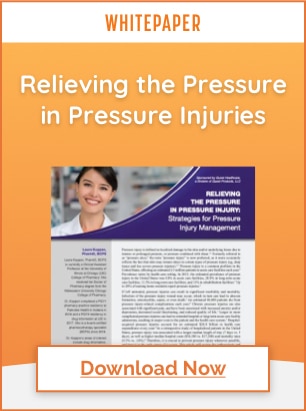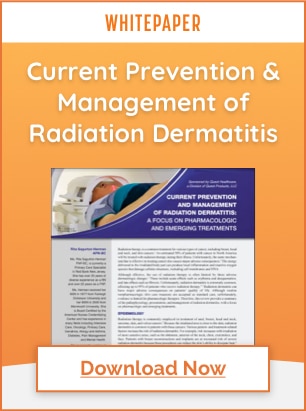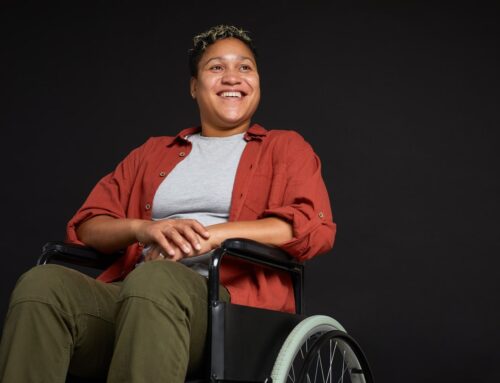
Incontinence-Associated Dermatitis and Pressure Injuries in the Mobility-Impaired
The risk of skin conditions such as incontinence-associated dermatitis (IAD) and pressure injuries increases significantly for mobility-impaired patients. Patients with incontinence have a 22% higher risk of developing pressure injuries. For the mobility-impaired, the risk increases to 30%.
It’s essential for healthcare providers and facilities to have an evidence-based skin care protocol, as well as effective bowel and bladder management programs, to prevent and treat skin breakdown for the mobility-impaired.
Incontinence in the Mobility-Impaired
For mobility-impaired patients, incontinence is a prevalent issue. In one study, a total of 43% of the mobility-impaired participants reported incontinence from less than once a week to daily.
The prevalence of pressure injuries is significantly higher for incontinent patients. Research showed that 1.6% of continent patients develop facility-acquired pressure injuries versus 6% for incontinent patients.
Excess moisture due to fecal and/or urinary incontinence can cause excoriation and chafing of the skin. Bandages and wound coverings can also cause excess accumulation of moisture under the protected area. Prolonged exposure to moisture causes the loss of layers of skin, which can result in skin sores and injuries.
Differentiating Between Incontinence-Associated Dermatitis and Pressure Injuries
Studies have shown that differentiating between IAD and pressure injuries can be difficult for healthcare professionals. Misclassification can lead to improper prevention and treatment. Education about how to differentiate between the two conditions is needed.
Incontinence-associated Dermatitis
IAD is an inflammation of the skin that occurs when urine or stool comes in contact with the perineal or perigenital skin. Incidents of IAD are higher in patients with fecal incontinence, however urinary incontinence alone is still a significant issue.
With IAD, the wound is only caused by prolonged exposure to urine, feces, or both. It appears as a diffuse rash usually around the perineum, perigenital, buttocks, lower back, and upper thighs. The skin is typically intact, with erythema, and is red or bright red in color. The injury does not extend beyond the epidermis and/or dermis, and is two-dimensional with poorly defined edges.
Pressure Injuries
With pressure injuries, ischemia occurs due to pressure on the skin, usually over bony prominences. Necrosis may be present and the injury appears red and/or bluish-purple. The depth of the wound is typically three-dimensional with partial-to-full thickness resulting in deep tissue injury. The wound has distinct edges or margins.
To differentiate between IAD and pressure injuries accurately, it’s important to obtain a comprehensive health history, including the patient’s toileting and bathing routine. Adequate lighting is needed for accurate inspection of the skin and avoid fluorescent lighting which can cast a bluish tint on dark skin.
Inspect skin from multiple angles for changes in color around the injury. Note that hyperpigmentation could be a sign of early skin injury for patients with dark skin. Palpate the area to look for changes in texture and/or temperature. Heat, edema, and/or change is tissue consistency may be indicative of a pressure injury.
Prevention and Treatment of IAD and Pressure Injuries
It’s vital to cleanse, moisturize, and protect skin for incontinent, mobility-impaired patients. Use skin emollients to keep skin hydrated and reduce the risk of damage. It’s especially effective to moisturize skin directly following bathing. Use a barrier product to protect skin from excess moisture and pressure damage.
When bathing, avoid scrubbing and towel drying, which can irritate skin. Avoid products with any fragrances to avoid potential irritants.
Use a turning schedule to help prevent pressure injuries from forming. Ensure the patient’s body is aligned and free of pressure around bony prominences.
Evaluate all equipment, including wheelchairs, beds, external catheters, leg bags, and braces to ensure they fit properly and are not causing abrasions or damage to the skin. Transfers should be performed safely and carefully to avoid shearing of the skin.
Clothing that is too loose or too tight can exacerbate skin injury. Avoid sitting or lying on seams or pockets. Routinely examine patients’ skin for signs of redness, rashes, or injury. Ensure that the patient has an effective bowel management program to prevent skin breakdown.
ENEMEEZ® Can Help
The ENEMEEZ® formulation is a hyperosmotic, stool-softening laxative that works by drawing water into the bowel from surrounding body tissues. The docusate sodium in this mini enema product prepares the stool to readily mix with watery fluids. Not only does it soften and loosen the stool, but it initiates a normal, replicated bowel movement within 2-15 minutes.
ENEMEEZ® Plus contains 20mg of benzocaine, assisting in the anesthetization of the rectum and lower bowel. This formulation was developed for patients who experience autonomic dysreflexia, hemorrhoids, fissures, or painful bowel movements.
ALOCANE® PLUS Can Help
ALOCANE® Plus can relieve pain and itching associated with dermatitis, early stage pressure injuries, sutures/staples, first degree burns, psoriasis, eczema and shingles. The active ingredient, lidocaine HCL 4%, provides rapid pain relief caused by skin irritation and benzalkonium chloride .13% works as an antimicrobial agent by killing microorganisms and inhibiting their growth. ALOCANE® Plus is an effective treatment for minor pain and itching, used in: Radiation oncology, long term care/hospice, dermatology, rehabilitation, convalescence, plastic/cosmetic surgery, and burn care.
Click here to request samples of Enemeez and/or ALOCANE Plus today.
Request an Educational In-Service
Request to schedule a free virtual 20-30 minute In-Service on The Correlation Between Fecal Incontinence and Pressure Injuries for your team today, and we’ll have lunch delivered to your office! Learn more and request an In-Service here.
Disclaimer: The material contained is for reference purposes only. Quest Healthcare, a Division of Quest Products, LLC, does not assume responsibility for patient care. Consult a physician prior to use. Copyright 2024 Quest Products, LLC.
Sources:
- https://pubmed.ncbi.nlm.nih.gov/19543157/
- https://www.sci-info-pages.com/skin-and-pressure-sores/
- https://pubmed.ncbi.nlm.nih.gov/19488052/
- https://qualitysafety.bmj.com/content/19/5/e3.short
- Long MA, Reed LA, Dunning K, Ying J. Incontinence-associated dermatitis in a long-term acute care facility. J Wound Ostomy Continence Nurs 2012;39(3):318-27.
- https://journals.lww.com/aswcjournal/fulltext/2018/11000/incontinence_associated_dermatitis__state_of_the.4.aspx#JCL-P-10
- http://www.shieldhealthcare.com/community/wp-content/uploads/2015/08/Shield-HealthCare-Skin-Damage-Presentation.pdf
- https://www.cec.health.nsw.gov.au/__data/assets/pdf_file/0014/424400/Distinguishing-Between-Incontinence-Associated-Dermatitis-and-Pressure-Injuries.pdf
- https://www.sci-info-pages.com/skin-management/
- http://www.shieldhealthcare.com/community/wp-content/uploads/2015/08/Shield-HealthCare-Skin-Damage-Presentation.pdf




![[Live Webinar] Neurogenic Bowel Dysfunction in Multiple Sclerosis](https://www.questhealthcare.net/wp-content/uploads/2025/02/325-Quest-Healthcare-Speaker-Session-1-500x383.png)


